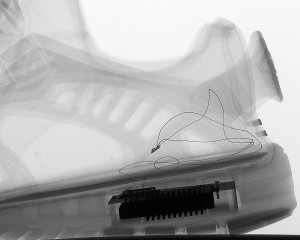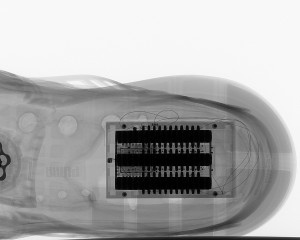Wearable devices, such as health monitors and sensors, are
of great interest. One of the major
limitations in making these devices a practical reality has been the power supply – the need for large, heavy batteries. Movement generates power and a human can produce 10s of Watts just from walking and up to a kilowatt when sprinting. Harvesting this energy has the potential to overcome the power supply problem and German researchers have recently built power harvesting
devices which are small enough to fit inside a shoe. The researchers have produced two devices, a swing harvester and a shock harvester. Both creations exploit the interaction between magnets and conductive coils to generate power.The aim was to create a self-lacing and unlacing shoe for the elderly, but this technology has many potential applications and could be used to power wireless devices.



As the name suggests, the swing harvester generates power
when the foot is in motion. Multiple magnets are stacked within conductive
coils. When the foot swings, this stack of magnets moves through the coils,
inducing a voltage and causing current to flow though the windings. The amount
of power produced depends on the speed of movement – the faster you run, the
more power you generate.
The second invention, the shock harvester, produces power
when the heel strikes the ground. This device is composed of a spring loaded
magnetic circuit, containing three pairs of magnets, two coils and a magnetic
suspension system. When the heel hits the floor, the two magnets in the magnetic
suspension system begin to approach. This creates a repulsive force, pushing
the magnetic circuit back up. The spring loading causes the magnetic circuit to
oscillate, leading to power generation by resonant magnetic induction.
The energy output is small, up to 4 mW for the shock
harvester. A smartphone requires around 5 W (5000 mW), but these devices are still
capable of powering small sensors and wireless transmitters. As the output is
directly related to the size of the system, making the devices larger would
yield more power. Previous designs have produced up to 250 mW, but were
impractically large. The same researchers are currently working on new models,
which promise a significant increase in power without a large increase in size.
Details about the project entitled "Energy harvesting
from human motion: exploiting swing and shock excitations" (Authors: K.
Ylli, D. Hoffmann, A. Willmann, P. Becker, B. and Y. Manoli Folkmer) are
published in IOP Publishing's journal "Smart Materials and
Structures" at:
http://iopscience.iop.org/article/10.1088/0964-1726/24/2/025029/meta;jsessionid=A9298B422A8116BF0B2E7473862F0F6C.c4.iopscience.cld.iop.org